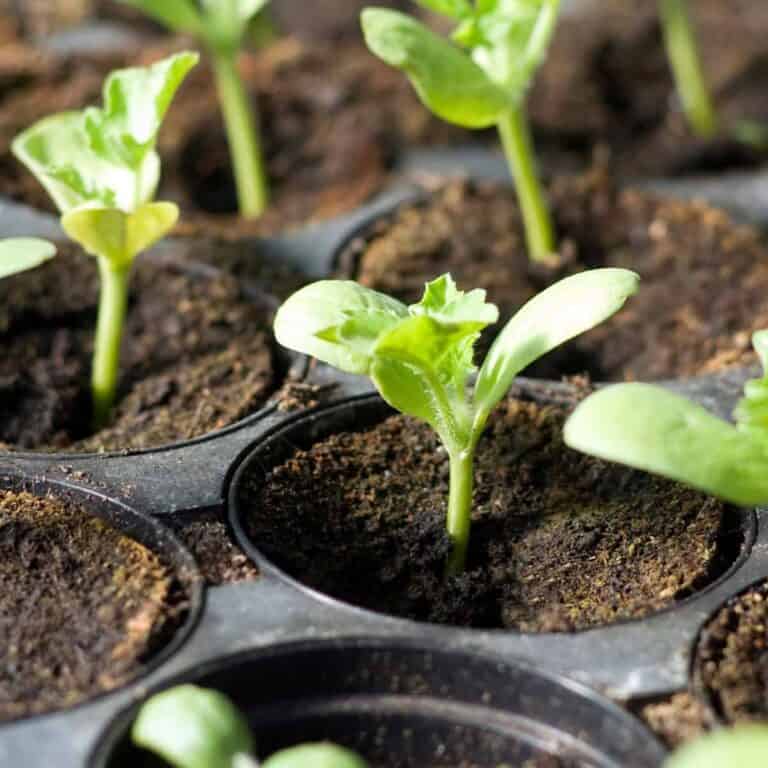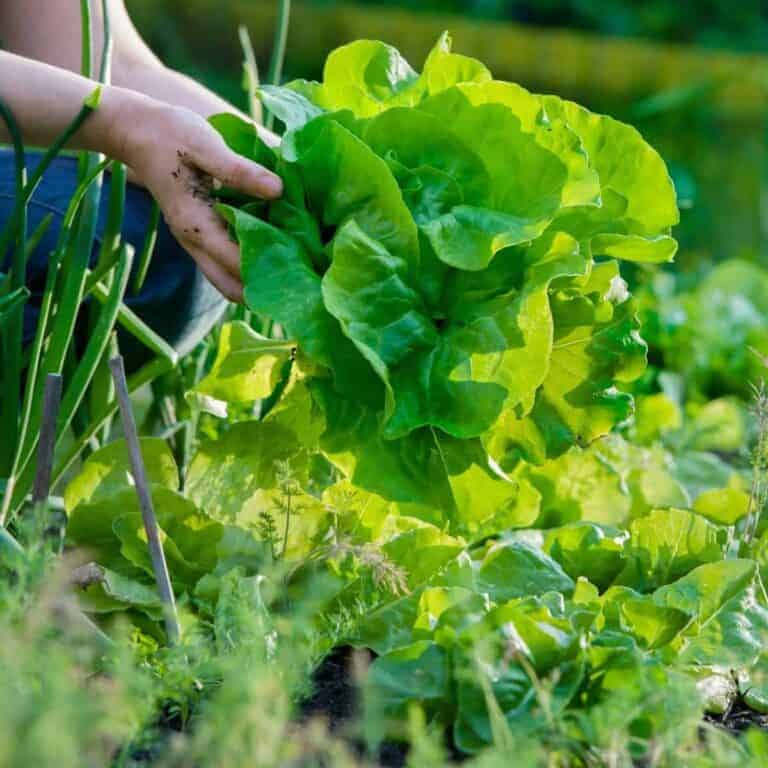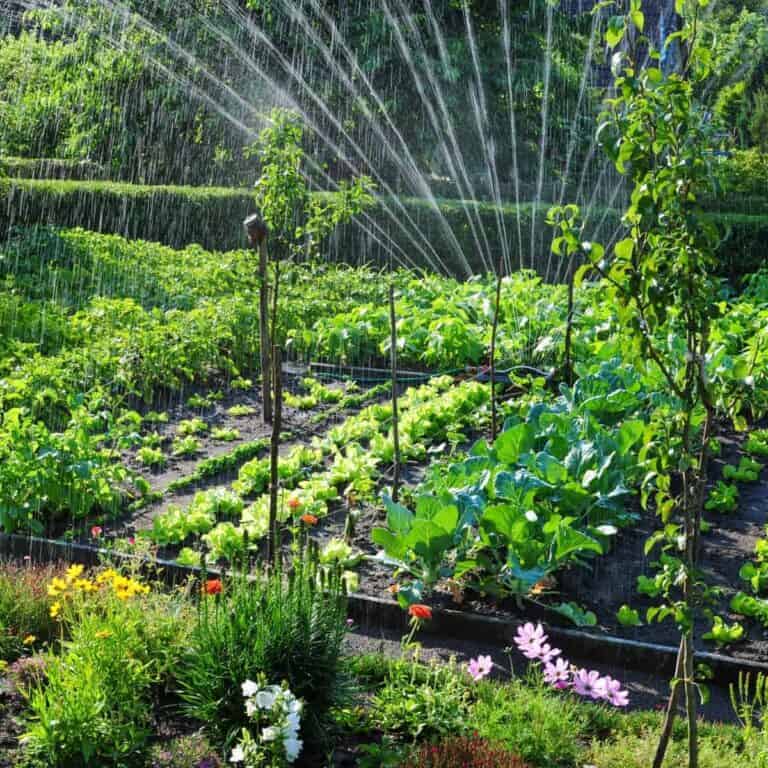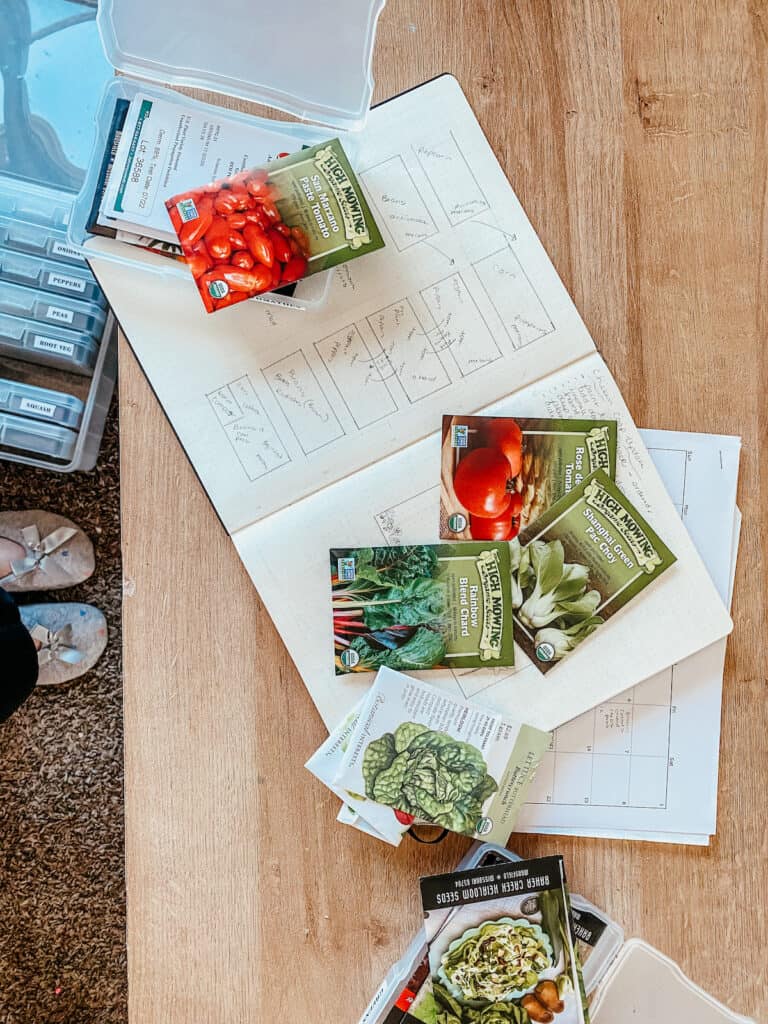How to Grow Tomatoes in a Raised Bed
Growing tomatoes in a raised garden bed is a great way to get healthy, productive plants—especially if you want to improve drainage, control soil quality, and reduce pests.
If you’ve been following the blog for any time, you know that raised bed gardening is my favorite method of gardening — for a variety of reasons.
And growing tomatoes is no exception. In this post, I’m sharing my favorite methods for growing tomatoes in raised garden beds.
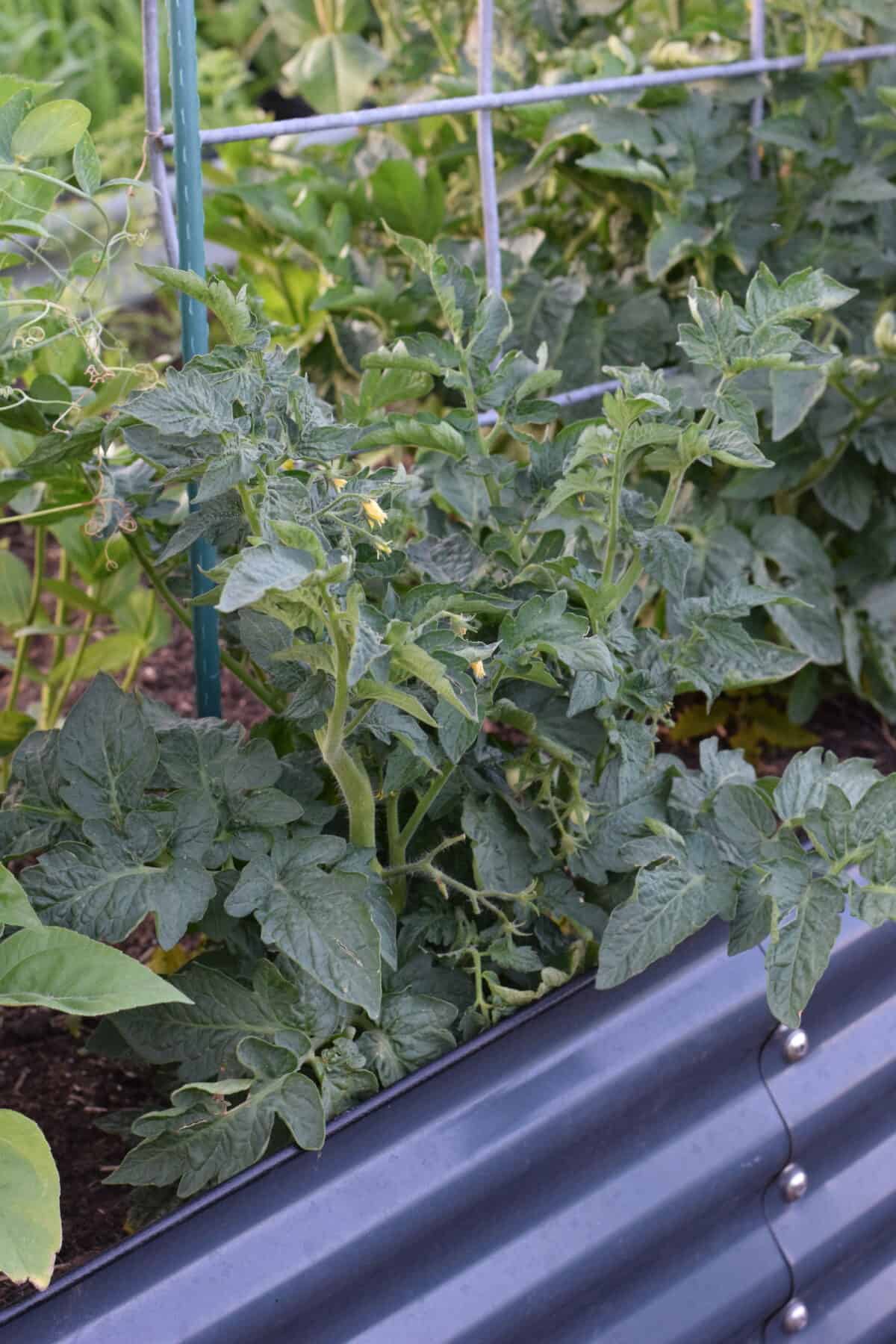
🪴 How to Grow Tomatoes in a Raised Garden Bed
In this post, we will cover the basics of what you need to grow a thriving harvest full of juicy and flavorful tomatoes in a super easy to manage method.
Before we get begin, I want to share a few tips to help you get started.
Handy tip: Prepare Ahead!
Let’s begin by gathering your materials and supplies in advance—this is key to a successful tomato-growing experience. Having everything organized will save you time and frustration during the planting process. Consider this preparation a crucial first step in your gardening journey.
Gather Your Supplies
Here’s a list of what you’ll need in growing tomatoes successfully in your garden.
Stakes, Cages, or Trellises
Installing stakes or cages early on provides the necessary support for your tomato plants as they grow tall and heavy with fruit. Using sturdy materials like metal or wood ensures that your plants remain upright and easily accessible for harvesting. Proper support not only helps with airflow and disease prevention but also encourages healthy, robust growth.
There are a variety of methods for trellising your tomatoes. Simple cages and stakes are a great option and the most accessible in most situations. Alternatively, we like like to use cattle panels and clips or garden tape in our raised beds.
Raised Bed Frame
A sturdy raised bed frame, ideally constructed from weather-resistant materials like cedar or composite lumber, serves as the structure for your tomato garden. Aim for dimensions of at least 4 feet wide and 2 feet high to provide ample growing space and facilitate easier access for maintenance. Choosing rot-resistant wood will ensure durability and longevity for years of fruitful gardening.
We like to use these galvanized metal raised beds in the garden for durability and long lasting ability.
Quality Soil
Invest in high-quality, nutrient-rich soil, such as a mix designed for vegetable gardening, to provide your tomatoes with the essential elements they need. Most often, you will find that it is recommended to use a blend which includes compost, peat moss, and perlite to retain moisture while ensuring good drainage.
HERE’S HOW WE FILL Our Raised beds:
- layer of cardboard, logs, branches & sticks or twigs.
- old rotted hay (kitchen scraps, leaves, grass clippings also works)
- compost – homemade compost is such a great option for keeping costs down and providing beneficial nutrients and organic matter for the garden. If purchasing compost, be sure to choose one of good quality and test it before planting to ensure it’s not too hot.
- Animal manure – this is gold for the garden. I recommend goat manure, if available. Chicken and cow manure is also good. Whichever option you choose, be sure to allow about 4 months of aging/composting before using it in the garden.
- organic topsoil – be sure to choose a high-quality soil for a vegetable garden.
Opt for organic options when possible to promote healthy growth without harmful chemicals.
Tomato Plants or Seeds
You can choose to plant young tomato seedlings or start from seeds, depending on your gardening preference and local climate. Popular varieties like Roma, Cherokee Purple, or Cherry offer diverse flavors and uses in the kitchen. When starting from seeds, be sure to follow the recommended planting depth and spacing for your selected variety to ensure optimal growth.
Watering Can or Hose
A watering can, preferably with a long spout, or a hose with a spray attachment, is crucial for delivering the right amount of moisture to your plants. Consistency in watering is important to keep your tomato plants thriving, especially during dry spells. Both options allow you to control the flow and ensure that the water reaches the base of your plants where it’s needed most.
Mulch
Organic mulch, such as straw, wood chips, or shredded leaves, is essential for retaining soil moisture and suppressing weeds in your raised bed. A layer of about 2 to 3 inches will help regulate soil temperature and prevent moisture evaporation during hot weather. It also provides beneficial nutrients as it breaks down over time, enriching the soil for your tomatoes.
Fertilizer
Selecting a slow-release, balanced fertilizer specifically designed for vegetables will enhance overall plant growth and fruit production. Nutrients like nitrogen, phosphorus, and potassium are crucial for healthy tomatoes, ensuring both lush foliage and bountiful harvests. Follow the packaging instructions for application rates to prevent over-fertilization, which can harm your plants.

Choosing Your Tomato Variety
Selecting the right tomato varieties is essential to ensure a successful harvest. Some tomatoes flourish better in your region’s climate or have specific uses based on your culinary needs. Researching and considering your options upfront makes the subsequent planting and growing phases much smoother.
It is important to remember that there are two main varieties of tomatoes:
- Determinate (bush type): Compact plants that stop growing once they set fruit. Great for small spaces and containers.
- Indeterminate (vining type): Keep growing and producing all season. Ideal for larger beds with staking or trellising.
🌿 Popular varieties: ‘Roma’, ‘Celebrity’ (determinate); ‘Brandywine’, ‘Sun Gold’, ‘Cherokee Purple’, ‘Early Girl’ (indeterminate).
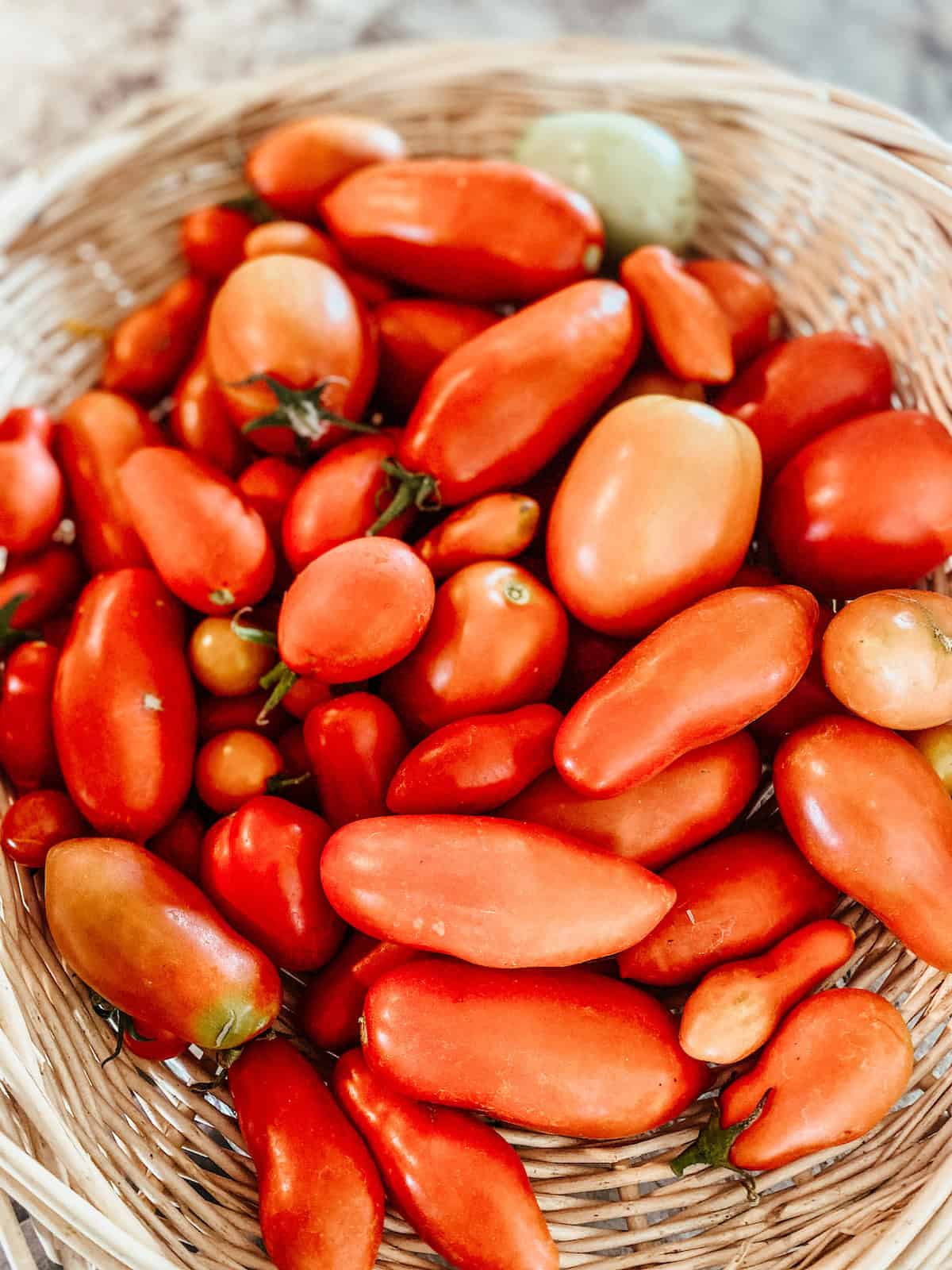
Research Local Climate and Tomato Varieties
Understanding your local climate helps you choose varieties well-suited to grow in your area. For instance, heirloom varieties may thrive in cooler conditions, while hybrid tomatoes can tolerate warmer climates.
Consult local extension services or gardening forums for personalized recommendations based on your region’s weather patterns. We grow in zone 5 and have been successful with almost all common and popular varieties or tomatoes for our area.
Determine Usage: Fresh Eating vs. Cooking
Decide whether you want to grow tomatoes primarily for fresh consumption, cooking, or both. Varieties specifically bred for fresh eating, like Cherry or Beefsteak, offer vibrant flavors, while cooking tomatoes like Roma are meaty and perfect for sauces. Understanding your intended uses helps guide your selection and ensures you enjoy every bite.
Also paste varieties (determinate) are great for canning and preserving methods.
Consider Growth Space Requirements
Different tomato varieties have varying growth habits, so consider how much vertical space your selected types will need.
Indeterminate varieties can grow tall and require more support, while determinate types are bush-like and may only need minimal staking. Keep spacing in mind to avoid overcrowding and encourage healthy airflow between your plants.
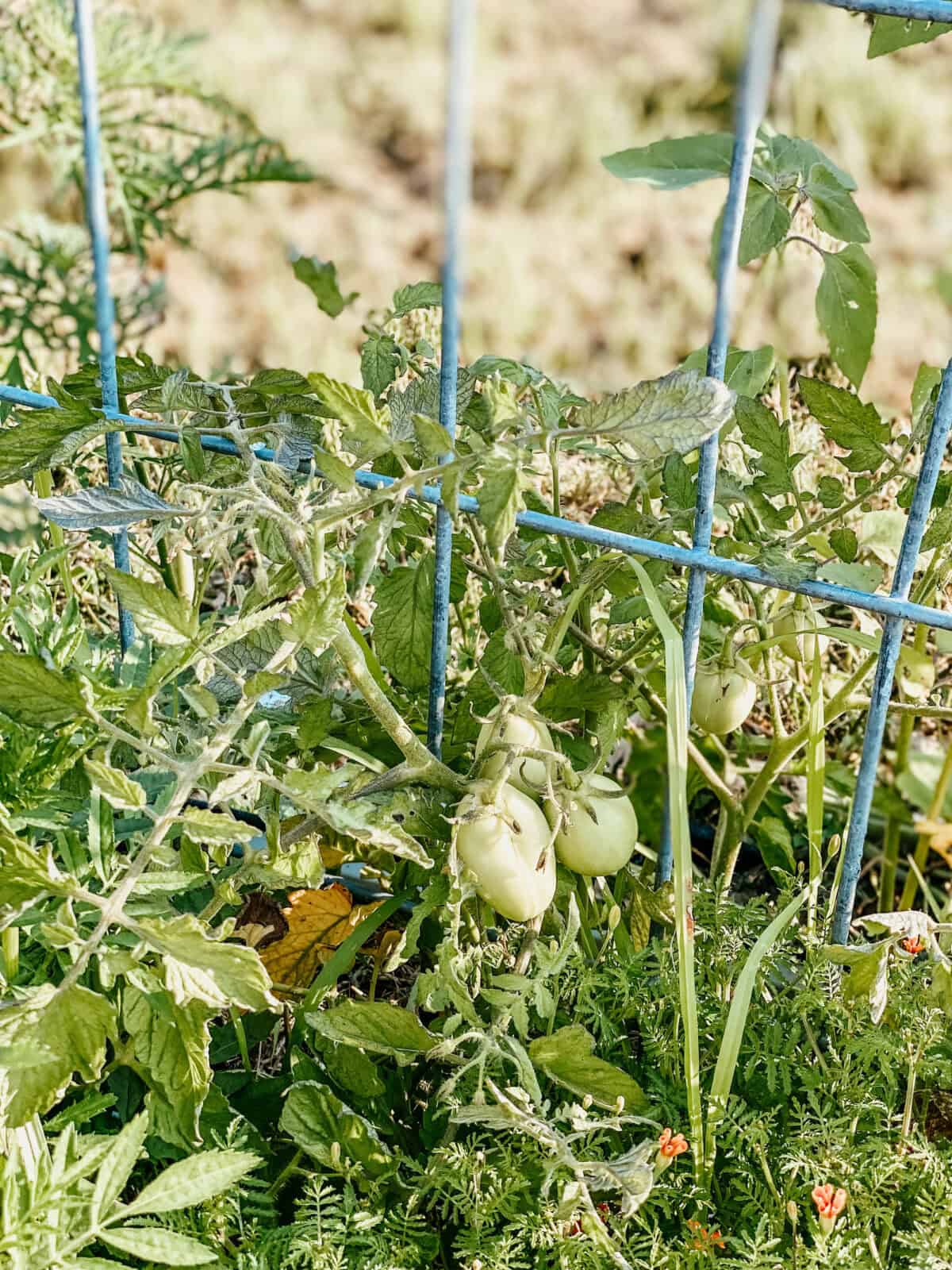
Consider Disease Resistance
Opt for disease-resistant varieties to minimize problems later. Resistant tomatoes are more robust, especially in humid conditions. Read seed packets carefully to identify suitable options.
Experiment with Heirloom Varieties
Heirloom tomatoes often boast unique flavors and colors. Consider adding a few for a special touch in your garden. They provide rich tastes and fascinating stories behind each variety.
Try Growing Different Colors of Tomatoes
Expand your palette by planting various colored tomatoes. Heirloom varieties can bring unique flavors and visual appeal to your garden. Experimenting with white, purple, and yellow tomatoes can transform your salads.
Incorporate Companion Planting
Planting herbs like basil alongside tomatoes can enhance growth and flavor. Certain combinations naturally deter pests and improve soil health. Consider planting marigolds nearby to keep unwanted bugs at bay.
Taking the time to select the right tomato varieties streamlines your gardening journey from the start. Knowing what types suit your taste and local climate will set you up for success as you move into the planting stage.

Choose the Right Location for Planting
Selecting the correct location for your raised bed is crucial to your tomato-growing success. Tomatoes thrive in full sun, so finding a spot that captures those sunny rays is essential. Additionally, considering drainage and accessibility will support healthy growth and maintenance of your tomato plants.
Assess Sunlight Exposure
Tomatoes require at least 6-8 hours of direct sunlight each day for optimal growth. Observe how sunlight moves across your garden area throughout the day to find the sunniest spot. Avoid placing your raised bed in shaded areas created by trees or structures, as this will hinder healthy tomato development.
Check for Good Drainage
Ensure that the chosen location has good drainage to prevent waterlogging. Wet soil can lead to root rot and other diseases, hindering tomato production. Look for areas where runoff occurs or test by digging small holes to observe how quickly water drains away.
Consider Proximity to Water Sources
Choosing a location close to your water supply is vital for easy maintenance. Easy access means you’ll be more likely to keep your plants hydrated, which is crucial for their growth and fruit production. Plan for a nearby hose or watering can station to make the process more efficient.
Knowing the right spot for your raised bed gives your tomatoes the best chance to thrive. Investing time in properly assessing sunlight and accessibility ensures a fruitful harvest.
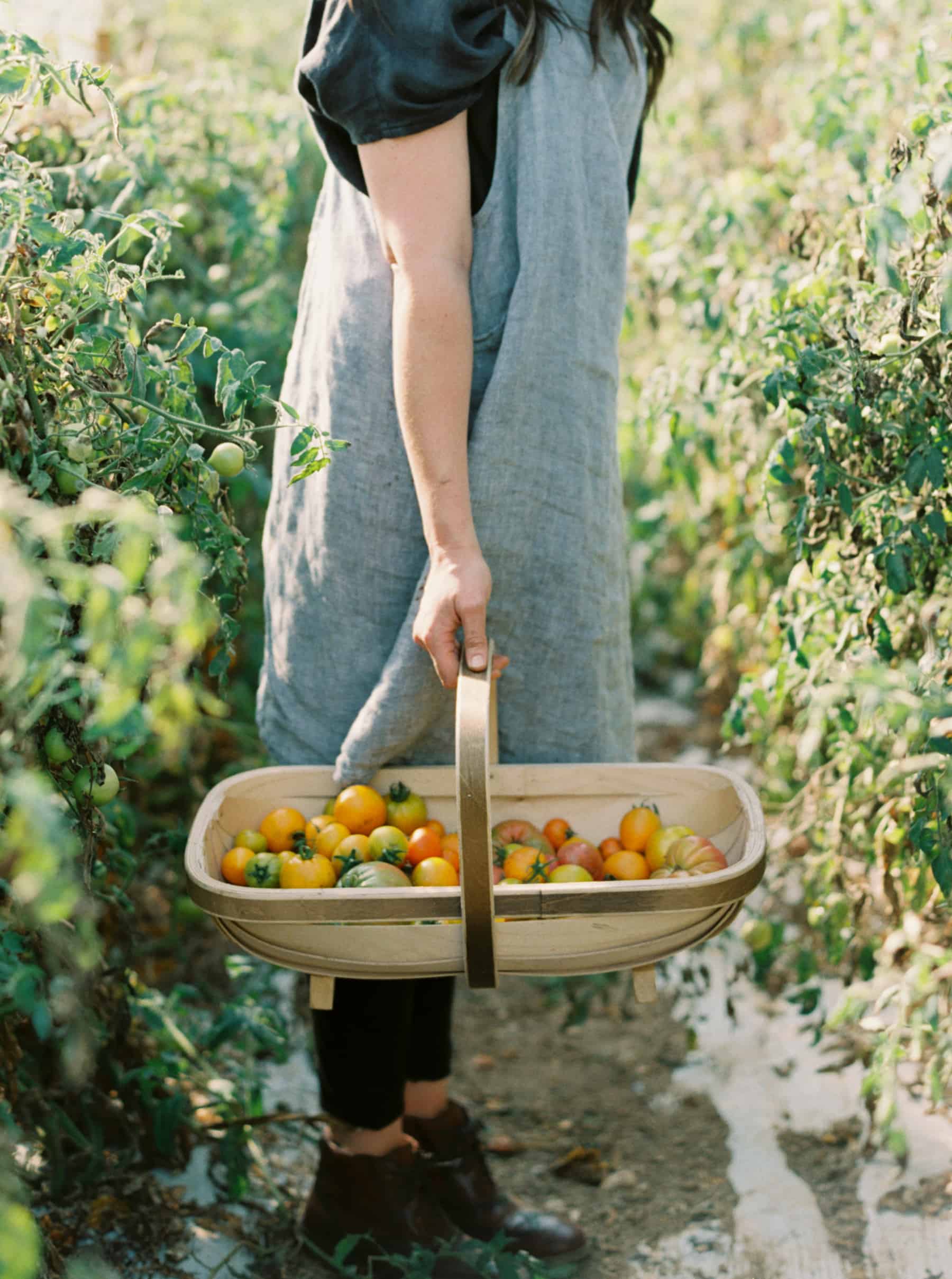
Utilize Vertical Gardening Solutions
If space is limited, consider growing tomatoes vertically using trellises or cages. This maximizes light exposure and minimizes disease risks. Vertical gardening allows for more efficient use of your space while adding visual interest to your garden.
Plant a Barrier of Herbs Around Your Raised Bed
Creating a border of aromatic herbs can enhance garden aesthetics and deter pests. Plants like rosemary and lavender can mask tomato scents — which is helpful to deter unwanted insects. Plus, their fragrances add charm to your gardening experience.
Test Soil pH Before Planting
Before planting, consider testing your soil pH for ideal tomato growth conditions. Tomatoes prefer a slightly acidic to neutral range (6.0 to 7.0). Amending your soil based on these tests can significantly impact your plants’ health.

Preparing Your Raised Bed
Before planting, thoughtfully preparing your raised bed is essential for your tomatoes’ health and productivity. Proper preparation creates a nutrient-rich environment that encourages robust growth and a bountiful harvest. By taking the time to properly set up your bed, you ensure your plants start their journey on the right foot.
Level the Soil Within the Raised Bed
Start by leveling the soil in your raised bed for even distribution. This step ensures that water drains evenly throughout the bed and reduces the risk of pooling in any one area. Use a rake to achieve a smooth and consistent surface, promoting healthy root development as your tomato plants grow.
✨ Mix in composted manure or organic tomato fertilizer before planting for a nutrient-rich start.
Add Organic Matter or Compost
Incorporate organic matter like compost to enrich the soil. Incorporating a 3 to 4-inch layer of well-rotted compost boosts nutrient content, enhances soil structure, and improves water retention abilities. This nutrient infusion creates an ideal environment for tomato roots to expand and thrive.
Create Adequate Drainage Holes
Ensure your raised bed has proper drainage holes to avoid waterlogged conditions. Drainage is vital for robust tomato growth, as excess moisture can lead to root disease. If using a pre-built frame, double-check for built-in drainage holes and ensure the base allows water to escape freely.
Taking these preparatory steps not only enhances your tomato plants’ development but also sets the stage for successful harvesting later. Well-prepared soil serves as a foundation for your tomato garden, fostering healthy growth and resilience.

Planting Tomatoes in Raised Beds
With a solid plan and the right supplies, it’s finally time to plant your tomatoes. This step requires careful attention to detail, ensuring that your plants are positioned correctly to promote healthy growth. Timing and depth are the keys to planting success.
Space Your Plants Based on Variety
Different tomato varieties have specific spacing requirements, so make sure to follow guidelines for each one. Generally, indeterminate varieties need at least 24-36 inches apart, while determinate types can be closer, at around 18-24 inches. This spacing allows ample air circulation and prevents diseases caused by overcrowding.
Want to save this?
Plant at the Correct Depth
Plant Deeply: Bury ⅔ of the tomato plant (including part of the stem). New roots will form along the buried stem, making the plant stronger.
When planting your seedlings, bury them deep—up to the first set of true leaves. This deep planting encourages strong root development, which ultimately supports better growth. Tomatoes readily develop roots along their buried stems, making this technique particularly effective.
Support the Plants: Install tomato cages, stakes, or trellises at planting time to avoid disturbing the roots later. Indeterminate varieties especially need strong vertical support.
Water Thoroughly After Planting
After placing your tomato plants into their holes, ensuring they are securely positioned, water them thoroughly. Using a gentle spray, make sure that the soil around the roots is well-saturated but avoid waterlogging. Adequate watering helps your plants settle into their new environment and reduces transplant shock.
🥄 Add crushed eggshells or a bit of bone meal in the hole to boost calcium and prevent blossom end rot.
Making sure to plant your tomatoes with the right spacing and depth leads to healthier, more productive plants. Proper planting techniques reduce the risks of diseases and ensure robust growth, setting you up for a fruitful harvest.
Watering Tomatoes Properly
Ensuring your tomatoes receive the right amount of water is critical to their health and productivity. The balance of moisture affects everything from growth to fruit flavor, making the watering technique a vital aspect to master. Understanding when to water and how much is essential.
Water Consistently and Deeply
Tomatoes thrive with consistent and deep watering, about 1-2 inches per week. Utilize a moisture meter to help gauge if your soil needs watering—aim for about an inch of water penetrated to the root zone. Deep watering encourages deep root growth, improving drought resistance as your plants mature.
Avoid Overwatering
While ensuring your tomatoes receive enough moisture, be cautious not to overwater. Overly saturated soil can lead to root rot, a common issue among tomato plants. Monitor the soil’s surface; it should feel moist but not waterlogged.
Utilize Mulch to Retain Soil Moisture
Mulching around your plants helps retain soil moisture and reduce evaporation. Choose organic mulch like straw or hay, applying a 2-3 inch layer around your tomato base. This practice not only retains moisture but also suppresses weeds, providing a dual benefit.
✨ Our favorite mulch to use in raised beds is this Garden Straw.
Water Early in the Day
Water your tomatoes early in the morning to prevent evaporation losses. This timing allows your plants to absorb moisture before the sun heats the soil. Morning watering also minimizes the risk of fungal diseases during the humid parts of the day.
Monitor Weather Conditions
When it rains, adjust your watering routine accordingly. Too much rain can cause flooding, while too little will necessitate deeper watering. Stay flexible with your watering schedule based on local weather changes.
Hold Off On Watering During Specific Times
If your plants show signs of wilting, try holding off on watering for a day. Sometimes, too frequent watering can be a problem. Allowing some stress encourages your tomatoes to focus on ripening, resulting in enhanced flavors.
Mastering effective watering techniques will ultimately support the robust growth of your tomato plants. Best practices not only lead to more fruit but also enhance the taste and overall quality of your harvest.

Fertilizer Tips
Using the right fertilization techniques will help you achieve bumper crops of delicious tomatoes. As plants grow, their nutrient needs change, so understanding how and when to provide nourishment is essential. Optimizing fertilization practices ensures healthy plant growth and fruitful yields.
Follow a Fertilization Schedule
Understanding when to fertilize your tomatoes can significantly influence their growth and fruit production. Begin fertilizing approximately two weeks after planting, using a balanced fertilizer every 4-6 weeks. As the plants start producing tomatoes, consider switching to a fertilizer higher in potassium to enhance fruit flavor and size.
Use Organic Options When Possible
Opt for organic fertilizers, like fish emulsion or compost tea, to promote healthy growth without harsh chemicals. Organic options contribute beneficial microbes to your soil, supporting stronger root systems. Always follow package instructions to avoid over-fertilization.
✨ This is our favorite fertilizer for tomato plants.
Observe Plant Needs
Monitor your tomato plants for any signs of nutrient deficiencies, such as yellowing leaves or stunted growth. If you notice these signs, consider a nutrient boost, specifically nitrogen or micronutrients. Adjusting your fertilization based on plant needs promotes balanced and uninterrupted growth.
Test Soil Nutrients
Consider starting your gardening journey with a soil test. Understanding the initial nutrient content allows you to tailor your fertilization strategy effectively. Some local garden centers often provide testing services. Or you can purchase a simple test online.
By implementing strategic fertilization techniques, you set your tomatoes up for success. Adequate nutrition fuels vigorous growth and helps sustain healthy plants throughout the season, culminating in flavorful harvests.
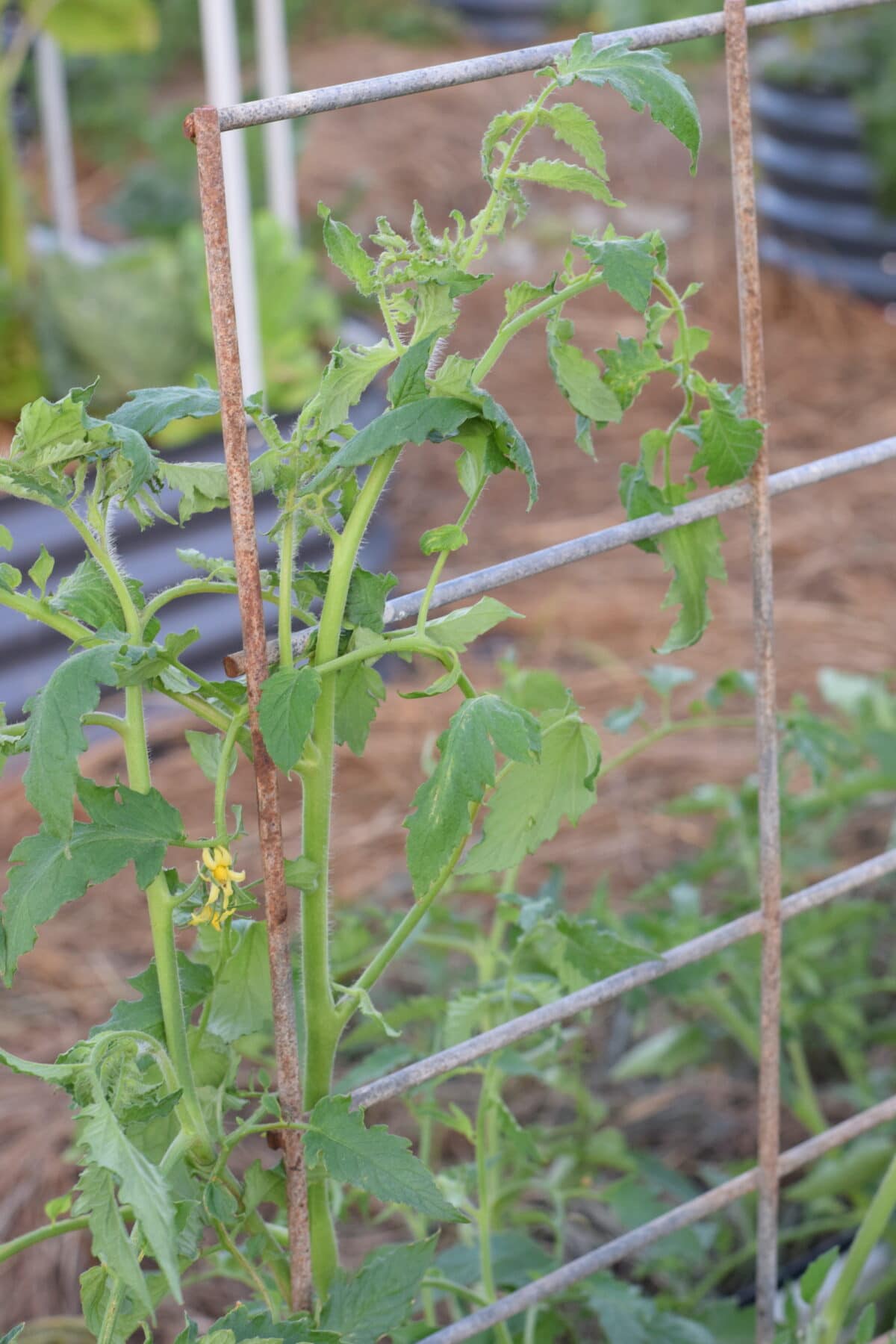

Support for Your Tomatoes
Providing appropriate support for your tomato plants is essential for encouraging healthy growth and maximizing yields. Utilizing stakes, cages, or trellises ensures that plants grow upright and remain safe from pests and diseases. This preparatory step can significantly influence the quality and quantity of your tomato harvest.
And let me tell you — there are SO many different support methods. If you’re a beginner gardener, it can become quite overwhelming! But, don’t let this get to you. Try a method out and if it doesn’t work for you, try something else.
I mean, from Florida weave and ‘a’ frames to stake cages and trellises—which should you choose? What is the BEST method? Personally, I like a simple cattle panel with garden clips or tape. But this is all personal preference and what your needs are.
Choose Support Type Based on Variety
Selecting the right support method correlates with the variety you’re growing; indeterminate types benefit from vertical supports, while determinate types may only require less intensive staking or cage systems. Consider your plants’ growth habits when deciding how to best provide structure and safety. This attention to detail promotes effective growth and enhances overall yields.
Install Supports Early in Growth Stage
Introducing supports early in the planting cycle prevents damage to roots or stems when erecting supports later. Installing supports when plants are still small allows them to grow up and around structures as they mature, reducing stress. This proactive approach safeguards their growth journey and fosters healthier plants.
Train Plants to the Support Structure
Encouraging plant stems to attach to the support promotes stable, upright growth. Gently tying branches or using plant clips provides additional security, minimizing the risk of breakage during adverse weather. Consistent support training keeps growth focused and maximizes production by optimizing sunlight exposure.
Evaluate Support Choices Each Season
Review your support methods at the beginning of each season and adjust as necessary based on plant variety and growth expectations. Long-term adaptation leads to refined techniques and increased productivity over time. Regular reassessment is particularly useful for grappling with changing growing conditions.
Prevent Breakage with Soft Material
Use soft ties or fabric strips to secure plants gently without constricting stems. This precaution minimizes the stress on growing branches while offering ample support. Appropriate fastening prevents damaging the plant during growth cycles, enabling a healthier yield.
Consider Vertical Gardening Elements
Explore vertical gardening features to maximize growing space while maintaining aesthetic appeal. Utilizing decorative trellises can integrate flair while also providing necessary support to tomato vines. This approach contributes to the garden’s visual interest without sacrificing productivity.
Supporting your tomatoes helps them flourish while minimizing the likelihood of damage. A structured plant will grow stronger, ultimately leading to a greater yield come harvest time.
To Prune or Not to Prune?
Before I share what we do, I thought I would share a few pros/cons of pruning tomatoes. To be completely fair, this can vary a lot on your growing zone and the heat & humidity of your area.
Side note
Personally, I rarely prune our tomato plants. Generally, the summer is our busiest season on the ranch. My husband is extremely busy with the cattle and in the hay field. And I’m usually busy with prepping for the next homeschool year.
It’s just such a busy time that I try to keep the garden work as minimal as I can for my mental well-being. 😅
So, all that to say, I hardly ever prune the tomato plants. And with as many tomato plants as we grow, it is usually a tomato jungle. But, I don’t mind that.
Now, if you want it more organized and less chaotic — or if you live in an area where there is high humidity or your garden is prone to blight or fungal diseases, you may want to prune your plants to allow for better airflow.

Pest Management
Managing pests in your raised bed is a crucial step in nurturing healthy tomato plants and ensuring a robust harvest. Integrating preventive measures and being vigilant about pest threats can save your plants from decay or damage. A proactive approach to pest management can be both sustainable and effective in fostering thriving tomatoes.
Monitor for Common Tomato Pests
Keeping an eye out for common pests like aphids, hornworms, and aphids helps promptly identify issues before they escalate. Regular inspections allow early intervention through organic controls, sparing your plants from extensive harm. This vigilance promotes overall plant resilience and improves harvest outcomes.
Implement Natural Predators
Encouraging natural predators like ladybugs or lacewings can significantly help in managing harmful pest populations organically. Attracting these beneficial insects through companion planting or providing habitat ensures they actively contribute to your garden’s health. Utilizing natural predation minimizes reliance on chemical treatments while enhancing biodiversity.
Practice Organic Pest Control Techniques
Using organic options such as insecticidal soap or neem oil can effectively eliminate unwanted pests without risking the health of beneficial insects. Following product directions ensures you leverage their effectiveness while minimizing chemical sensitivity. Exploring these alternatives supports sustainable gardening practices while protecting your tomato plants.
Rotate Crops Annually
Practicing crop rotation can mitigate pest buildup from season to season. By changing the planting location of your tomatoes each year, you disrupt pests’ lifecycle patterns. This beneficial approach impacts the overall plant health and reduces the chances of infestations.
Introduce Companion Flowers
Utilizing flowers that attract pollinators and pest repellents can enrich your garden’s ecosystem. Options such as marigolds and nasturtiums not only beautify your garden but also protect against pests that might threaten tomato plants. Designing strategic floral arrangements promotes both pollination and pest containment.
Implement a Trap System
Setting up traps for pests offers a targeted approach to managing infestations without chemicals. Consider using sticky traps or bait traps that attract common tomato pests while sparing beneficial insects. These simple methods can help reduce pest populations significantly.
Vigilance and proactive measures work hand in hand to safeguard your tomato crop from pests. Implementing various management strategies sets the stage for healthy plants and maximizes your harvest.

Harvesting Tomatoes
Successfully harvesting your tomatoes represents the culmination of all your hard work and dedicated care. Knowing when to pick tomatoes and how to do so correctly can significantly impact flavor and enjoyment. Approaching your harvest with a method ensures maximum satisfaction and delicious results.
Look for Signs of Ripeness
Monitoring color changes in tomatoes is essential for determining when they are ready to harvest. Varieties typically shift from green to their final color—whether red, yellow, or purple—indicating optimal flavor. For the best taste experience, aim to harvest when they are fully colored and slightly firm but not hard.
Handle With Care
When harvesting, gently twist or cut the stem to avoid damaging the fruit or plant. Bruising can spoil your tomatoes quickly, affecting flavor and shelf-life. Employing care during this process ensures your harvest remains in great shape for culinary use.
Store Harvested Tomatoes Properly
Post-harvest, avoid refrigerating fresh tomatoes, as cold temperatures can diminish their rich flavor. Instead, place them in a single layer at room temperature to retain optimal taste. Enjoying fresh tomatoes within a few days promotes flavor best, enhancing your culinary creations.
Create Unique Recipes with Your Harvest
Utilize your homegrown tomatoes in creative ways to appreciate their fresh flavor. Experimenting with salsas, sauces, or salads introduces diverse meals to your table. Crafting unique culinary experiences encourages enjoyment and satisfaction for every tomato harvested.
🍅 Related: Dehydrating tomatoes for storage.

The satisfying culmination of your efforts comes with a successful harvest. By monitoring ripeness carefully and employing gentle handling techniques, you pave the way for enjoying your tomatoes at their peak.





